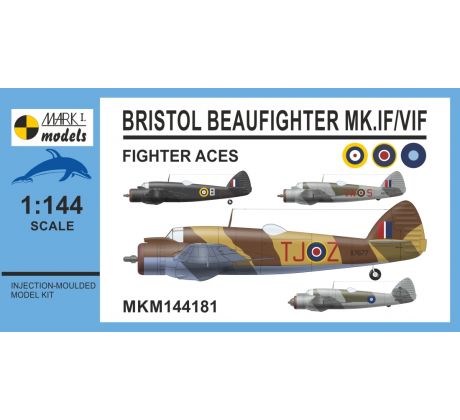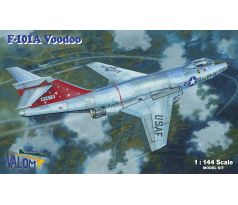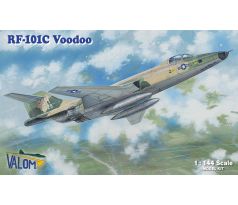Bristol Beaufighter ‘Aces’

Bristol Beaufighter ‘Aces’
This injection-moulded kit contains 51 parts, 5 resin parts and six clear parts (cockpit canopies, position lights etc.). A comprehensive instruction leaflet and a decal sheet are included. The rear side of the box comprises the representation of a tarmac section of the airfield which can be cut out and used as a display base for the assembled model.
Colour schemes included in the kit:
1) Bristol Beaufighter Mk.IF, X7750, Grey B, No.1435 Flt., RAF, flown by Flt Lt G.L. Hayton, Luqa airfield, Malta, March 1942
2) Bristol Beaufighter Mk.VIF, V8515, Red VA-S, No.125 (Newfoundland) Sq., RAF, flown by Flt Lt G.E. Jameson, Fairwood Common airfield, February 1943
3) Bristol Beaufighter Mk.IF, X7677, Red TJ-Z, No.272 Sq., flown by Flg Off E.E. Coate, RAF, Idku airfield (LG-229), Egypt, July 1942
4) Bristol Beaufighter Mk.VIF, ND220, No.176 Sq., RAF, flown by Sq Ldr J.H. Etherton, Minneriya airfield, Ceylon, April 1945
| Ref. No.: | MKM144181 |
| Availability: | IN STOCK |
Bristol Beaufighter ‘Aces’
The Bristol Beaufighter was a British heavy fighter, whose first prototype flew in July 1939. The first Beaufighter variants – the Mk.IF and Cs – were high performance fighters and long-range fighters, respectively, while the former Mark also became an efficient night-fighter, employing the then novel AI radar.
The Beaufighter was a two-seat, twin engine, all-metal mid-wing cantilever monoplane, fitted with a retractable undercarriage. It was powered by two Hercules radial engines and the armament consisted of four cannons in the nose, four guns in the starboard wing and another two guns in the port wing. The Beaufighter Mk.VIF, introduced in 1942, was fitted with more powerful engines and its wing mounted guns could be replaced by additional fuel tanks to extend the aircraft’s range.
Like its predecessors, the Mk.VIF was produced for Fighter Command and the Mk.VIC for Coastal Command. Some 1,840 Mk.VI aircraft were produced and this type remained in service until the summer of 1944. Late series aircraft were fitted with a dihedral tailplane with increased span and longer carburettor air scoops above the engine cowlings. From late 1943, a new AI Mk.VIII radar was installed in a “thimble-nose” radome, enabling all-weather and night attacks. The Beaufighter had a long career and served in almost all theatres of war during the WWII, at first as a night fighter, then as a fighter-bomber and eventually being used as a torpedo-bomber.
Products purchased together with this product

North American / Fiat F-86K SABRE DOG
Injected plastic model kit made by Ozmods Australia. Kit includes sprues from white plastic material, clear injected canopy and two vacuformad canopies and canopy mask. Decals sheets printed in Eduard Czech Republic offers two decal versions:
1) F-86K, BuNo 56-4131 of 2./JG74 - West Germany 1963
2) F-86K, BuNo 55-4819 of 12° Gruppo COT, 36° Stormo - Italy 1968
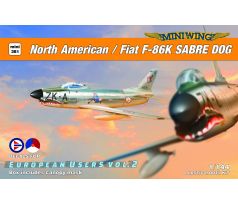
North American / Fiat F-86K SABRE DOG vol.2
Injected plastic model kit made by Ozmods Australia. Kit includes sprues from white plastic material, clear injected canopy and two vacuformad canopies and canopy mask. Decals sheets printed in Eduard Czech Republic offers two decal versions:
1) F-86K, BuNo 54-1251 of 337 Squadron of Royal Norwegian Air Force, Norway 1957
2) F-86K, BuNo 54-1337 of 702 Squadron of Royal Netherlands Air Force, The Netherlands 1960
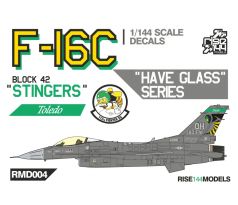
F-16C decals STINGERS OHIO ANG. VOL.2 (HAVE GLASS SCHEME)
1/144 Decals F-16C Stingers VOL.2 (Have Glass Scheme)
Digitally printed decals with silk screen film


